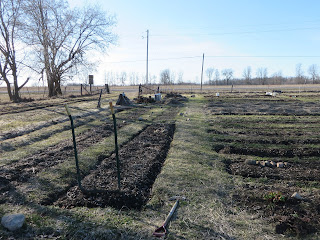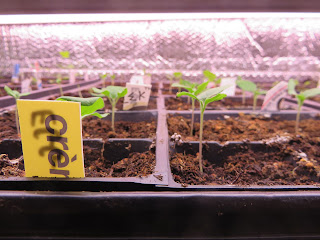Update as of April 19 2017: We have eight shares left to sell. If you are interested in taking part in the coming season, please order soon.
 Hello everyone:
Hello everyone:Happy Easter to you all, I hope this spring is treating you well.
Plenty is happening at the farm, read on.
I'll be going over accounts in the next day or two to ensure everyone is making their payments on time and double checking where we are at for customer count. I think there are only eight more shares left, so if you are still trying to decide, bear in mind space is limited.
Call now if you have any questions.
(613) 831-8218. I'mm usually home by 6 pm, though some evenings I am a bit late.
 The nursery is now getting crowed. The outdoor nursery is now ready for taking the oldest onions for all but the coldest nights (On those nights, the onions are placed on the storage shelves inside the nursery).
The nursery is now getting crowed. The outdoor nursery is now ready for taking the oldest onions for all but the coldest nights (On those nights, the onions are placed on the storage shelves inside the nursery).The nursery is almost full - we are onto the fourth bank of lights, with kale, chard, tomatoes and the third round of onions just starting to emerge in their seed trays.
Over the next few days, I'll be counting tomato seedlings and determining if any more need to be planted.

Here are your peppers at two weeks. They have opened their primary leaves and are establishing their roots.
We are growing four types of pepppers this season - Olympus, a standard green bell pepper; Lipstick, a cone shaped sweet peper, Hungarian Hotwax, a banana pepper that is somewhat hot; and Hungarian Black Pepper, somewhat hotter but not extreme, according to our hot pepper experts.

The celery is a little older, having progressed to its secondary leaf growth.
As with the peppers above, much of the growth is in the root systems, so the plant appears to be growing very slowly.
These will be following the onions to the outdoor nursery in the coming week, though spending the first few nights back inside until the weather gets a little warmer.

Along with all the work in the nursery, more tasks for outside are added to my spring routine.
Some of last year's late season beds need to be cleaned out - kale and brussel sprout stems need to be pulled and sent to the compost, and a few blades of grass and a few overwintered dandelions need removing,
Some beds near the edge of the buffer zone were left mostly untended last year until I knew for sure where the buffer zone was. These beds are first on the list, a task that will only get more difficult if left.
 The next beds to get cleaned up are the ones that are direct seeded early in the season - snow peas and spinach; and the first successions of carrots, beets, turnips, parsnip and rutabaga.
The next beds to get cleaned up are the ones that are direct seeded early in the season - snow peas and spinach; and the first successions of carrots, beets, turnips, parsnip and rutabaga. After that, the beds that take the first transplants are cleaned up - onions and parsley.
Fortunately, many of these were cleaned up last fall, and only need some light working.
 If this is not enough to seem daunting, the rock garden needs some cleaning, compost windrows need turning, and a broken part needs to be ordered for one of my tools.
If this is not enough to seem daunting, the rock garden needs some cleaning, compost windrows need turning, and a broken part needs to be ordered for one of my tools. A night of sub zero weather was put to use the other day. I added a bit of grass and clover seed to some paths that had a few bare patches.
I use all the help I can get.

Some beds need deep aeration - the tool pictured here is used for that it is called a broadfork.
The five tines reach 10 inches into the ground and create passages for moisture and air to get into. The air stimulated aerobic bacteria, which in turn speed up the decomposition process of organic matter, which in turn releases nutrients into the soil.
The passages also allow worms, bugs, and amphibians opportunity to move about in the soil easier.
 Insects and worms overwinter in the soil below the frost line, consuming organic matter and helping to break down nutrients that are deep in the soil - too deep for most crops to reach with their roots.
Insects and worms overwinter in the soil below the frost line, consuming organic matter and helping to break down nutrients that are deep in the soil - too deep for most crops to reach with their roots. When these soil dwellers sense the warmth of spring, they migrate to the surface, bringing these nutrients from below the root zone back up to the surface.
This is just one of many activities on the farm that develop soil health, which in turn leads to healthy food.
This is a photo of me using a broad fork in my first year working the earliest beds. The broadfork is one of my favourite tools to use. An excellent all body workout that will do the same things a treadmill, stationary bike, and rowing will do...and at the end, one can say the exercise accomplished something.

I have a few perennial crops. This is a self seeding bed of primroses in our rock garden.
The rock garden also contains oregano, thyme, sage, and amaranth flowers.
I am gradually establishing sorrel here as well.
Instead of broad forking, I use dandelions as my deep aerators. dandelions are biennial, so when their deep tap root dies, and decomposes, they provide the same kind of hole in the ground that the broadfork does.

Our first crop of the year - rhubarb leaves emerging from dormant plants.
Rhubarb is in the plant family Polygonaceae, which also includes sorrel and buckwheat.
I also grow buckwheat (as a cover crop), and I am establishing sorrel in one of the perennial beds as an additional herb.
The oldest rhubarb plants are ready for harvest in early June, a few of our customers shall receive some. The other plants will take another year or two to mature.









